Guide to the classics: steeped in the arboreal sublime, Thomas Hardy's The Woodlanders carries a startling urgency
- Written by Sophie Alexandra Frazer, Lecturer, the School of Liberal Arts, The University of Wollongong, University of Wollongong

In Thomas Hardy’s The Woodlanders (1887), the trees sing.
Sometimes the sound is like a Gregorian chant, a threnody from the rustling leaves, the creaking boughs, the undulations of limbs heavy with leaves, swaying in the wind that rushes through the woods of Dorset’s Little Hintock.
At other times, it is a low moan, a cry of pain, voiced as if in sympathy with the tragic plight of the characters who wander through these woods, searching for something lost or never quite possessed – for a Hardyian character is always driven by a restive compulsion to move.
Even in stillness, Hardy limns the minute transformations of the body – of human limbs cicatriced with tree wounds, or the trunk of one of the forest’s oldest inhabitants – pulsing with life, desire, will.
These sylvan protagonists – English oaks, crab-apples, silver birches, willows, blackthorns, hazel trees, ash-trees, and elms – come into life with a sigh, an audible exhalation sounding from deep inside the trunk.
Read more: Where the old things are: Australia's most ancient trees
The vocabulary of trees
The Woodlanders tells the story of a small community who live and work in the forest. They are woodcutters and spar-makers, fruit-pickers and timber dealers, busily industrious under the tree canopy that makes a second sky.
Human labour keeps time with the seasons in Little Hintock, the fictive hamlet that Hardy maps onto the topography of Dorset in the south of England: felling timber in the autumn and winter; pressing apples for cider in the spring and summer. Hardy’s tragic hero, Giles Winterborne, is continually evoked by the traces of labour that cling to his skin, hair and clothes: apple pips and pomace, the vestiges of pulpy matter on his hands.



